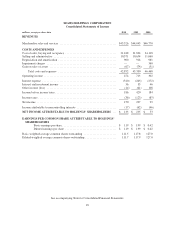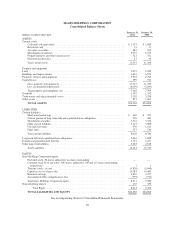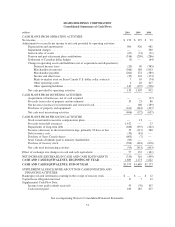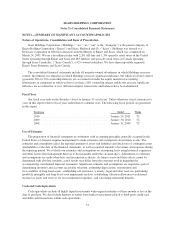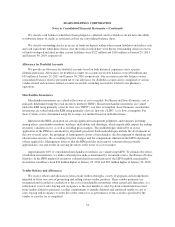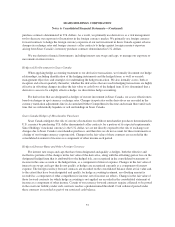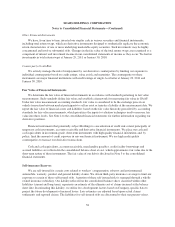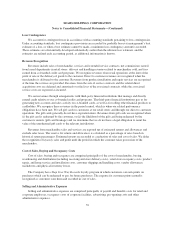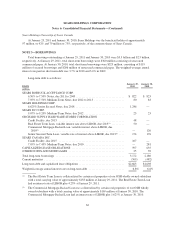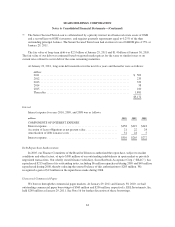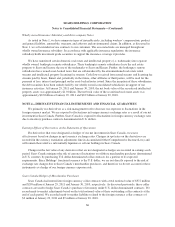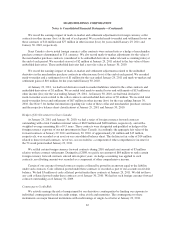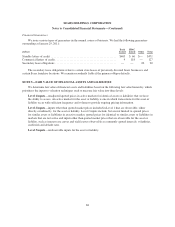Sears 2010 Annual Report Download - page 58
Download and view the complete annual report
Please find page 58 of the 2010 Sears annual report below. You can navigate through the pages in the report by either clicking on the pages listed below, or by using the keyword search tool below to find specific information within the annual report.SEARS HOLDINGS CORPORATION
Notes to Consolidated Financial Statements—(Continued)
Other Financial Instruments
We have, from time to time, invested our surplus cash in various securities and financial instruments,
including total return swaps, which are derivative instruments designed to synthetically replicate the economic
return characteristics of one or more underlying marketable equity securities. Such investments may be highly
concentrated and involve substantial risks. Changes in the fair value of the total return swaps are recognized as a
component of interest and investment income in our consolidated statements of income as they occur. We had no
investments in total return swaps at January 29, 2011 or January 30, 2010.
Counterparty Credit Risk
We actively manage the risk of nonpayment by our derivative counterparties by limiting our exposure to
individual counterparties based on credit ratings, value at risk and maturities. The counterparties to these
instruments are major financial institutions with credit ratings of single-A or better at January 29, 2011 and
January 30, 2010.
Fair Value of Financial Instruments
We determine the fair value of financial instruments in accordance with standards pertaining to fair value
measurements. Such standards define fair value and establish a framework for measuring fair value in GAAP.
Under fair value measurement accounting standards, fair value is considered to be the exchange price in an
orderly transaction between market participants to sell an asset or transfer a liability at the measurement date. We
report the fair value of financial assets and liabilities based on the fair value hierarchy prescribed by accounting
standards for fair value measurements, which prioritizes the inputs to valuation techniques used to measure fair
value into three levels. See Note 4 to the consolidated financial statements for further information regarding our
derivative positions.
Financial instruments that potentially subject Holdings to concentration of credit risk consist principally of
temporary cash investments, accounts receivable and derivative financial instruments. We place our cash and
cash equivalents in investment-grade, short-term instruments with high quality financial institutions and, by
policy, limit the amount of credit exposure in any one financial instrument. We use high credit quality
counterparties to transact our derivative transactions.
Cash and cash equivalents, accounts receivable, merchandise payables, credit facility borrowings and
accrued liabilities are reflected in the consolidated balance sheet at cost, which approximates fair value due to the
short-term nature of these instruments. The fair value of our debt is disclosed in Note 3 to the consolidated
financial statements.
Self-insurance Reserves
We are self-insured for certain costs related to workers’ compensation, asbestos and environmental,
automobile, warranty, product and general liability claims. We obtain third-party insurance coverage to limit our
exposure to certain of these self-insured risks. A portion of these self-insured risks is managed through a wholly
owned insurance subsidiary. Our liability reflected on the consolidated balance sheet, classified within other
liabilities (current and long-term), represents an estimate of the ultimate cost of claims incurred at the balance
sheet date. In estimating this liability, we utilize loss development factors based on Company-specific data to
project the future development of incurred losses. Loss estimates are adjusted based upon actual claims
settlements and reported claims. The liabilities for self-insured risks are discounted to their net present values.
58



